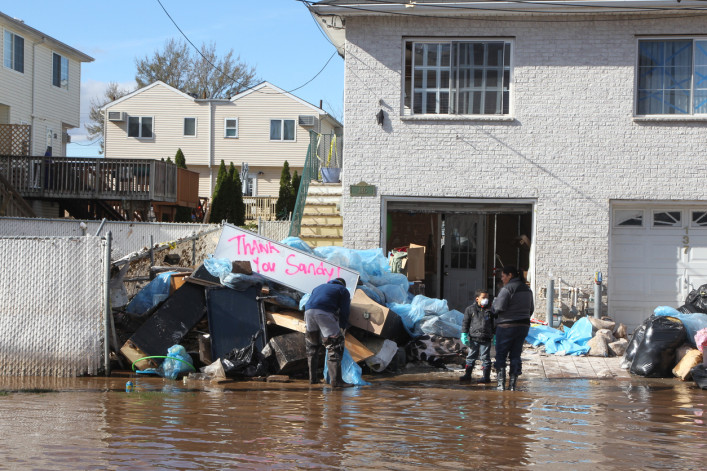Worried about climate change? Check the sales listing for extreme weather risk before you make an offer
- Zillow is the latest to inform buyers about flood, wildfire, wind, heat, and air quality
- Redfin, Realtor.com, and Homes.com also provide climate change data from First Street

A house in Staten Island damaged by Hurricane Sandy in 2012. Zillow, Redfin, Realtor.com, and Homes.com have added climate risk information from First Street to sales listings to better inform buyers.
iStock
Buyers face a gamut of fraught decisions and with the increase in severe weather events, weighing a property’s climate change risk is one of them.
More than 80 percent of buyers consider climate risk, primarily flooding, when looking for a new place, as per a 2023 Zillow report.
To help buyers make more informed decisions, major real estate sites Zillow, Redfin, Realtor.com, and Homes.com have added climate risk information to sales listings. The data is provided by First Street, a climate risk modeling company.
Why it is important to know a property’s climate risk
Zillow is the newest listings site to add climate risk information; the other sites added First Street climate risk data in recent years.
Buyers searching the Zillow app can see information on five types of extreme weather-related risks—flood, wildfire, wind, heat and air quality—as part of every sales listing.
Zillow listings also provide insurance recommendations and historical insights, showing if or when a property has experienced past climate events, such as flooding or wildfires.
"Climate risks are now a critical factor in home-buying decisions," said Skylar Olsen, chief economist at Zillow, in a press release. "As concerns about flooding, extreme temperatures and wildfires grow—and what that might mean for future insurance costs—this tool also helps agents inform their clients in discussing climate risk, insurance and long-term affordability."
Climate risk information will be available on the Zillow app for Apple devices and on the Zillow website by the end of the year, with Android availability expected early next year.
What the climate risk data tells you about a listing
Across all new listings of existing properties in the U.S., more than half (55.5 percent) have a major risk of extreme heat and a third are at major risk of extreme wind exposure, according to a Zillow analysis conducted in August.
That compares to 16.7 percent with major wildfire risk, 13 percent with major air quality risk, and 12.8 percent with major risk of flooding.
Still, it can be startling to see negative information about climate risk included along with more mundane details in a real estate listing.
For example, a suburban listing Brick chose at random on Realtor.com has a “severe” risk of flooding.
“This property has a 99.70 percent risk of flooding over 30 years. This property’s risk of flood is increasing as weather patterns change.” Yikes.
What do buyers do with climate risk information?
As you may have guessed, extreme flood risk can be a deterrent to buyers.
A 2022 Redfin report found buyers with access to flood risk information for online listings are more likely to view and make offers on homes with lower flood risk than those who don’t have access. The report was based on a three-month test with 17.5 million Redfin.com users, half of which had access to property flood-risk scores and half of which did not.
Redfin users who viewed homes with an average flood-risk score of 8.5 (severe/extreme risk) prior to the study went on to bid on homes with an average score of 3.9 (moderate risk) after getting access to flood-risk data.
By comparison, users who viewed homes with an average score of 8.5 before the study but did not get access to risk data went on to bid on homes with an average score of 8.5.
You Might Also Like



























